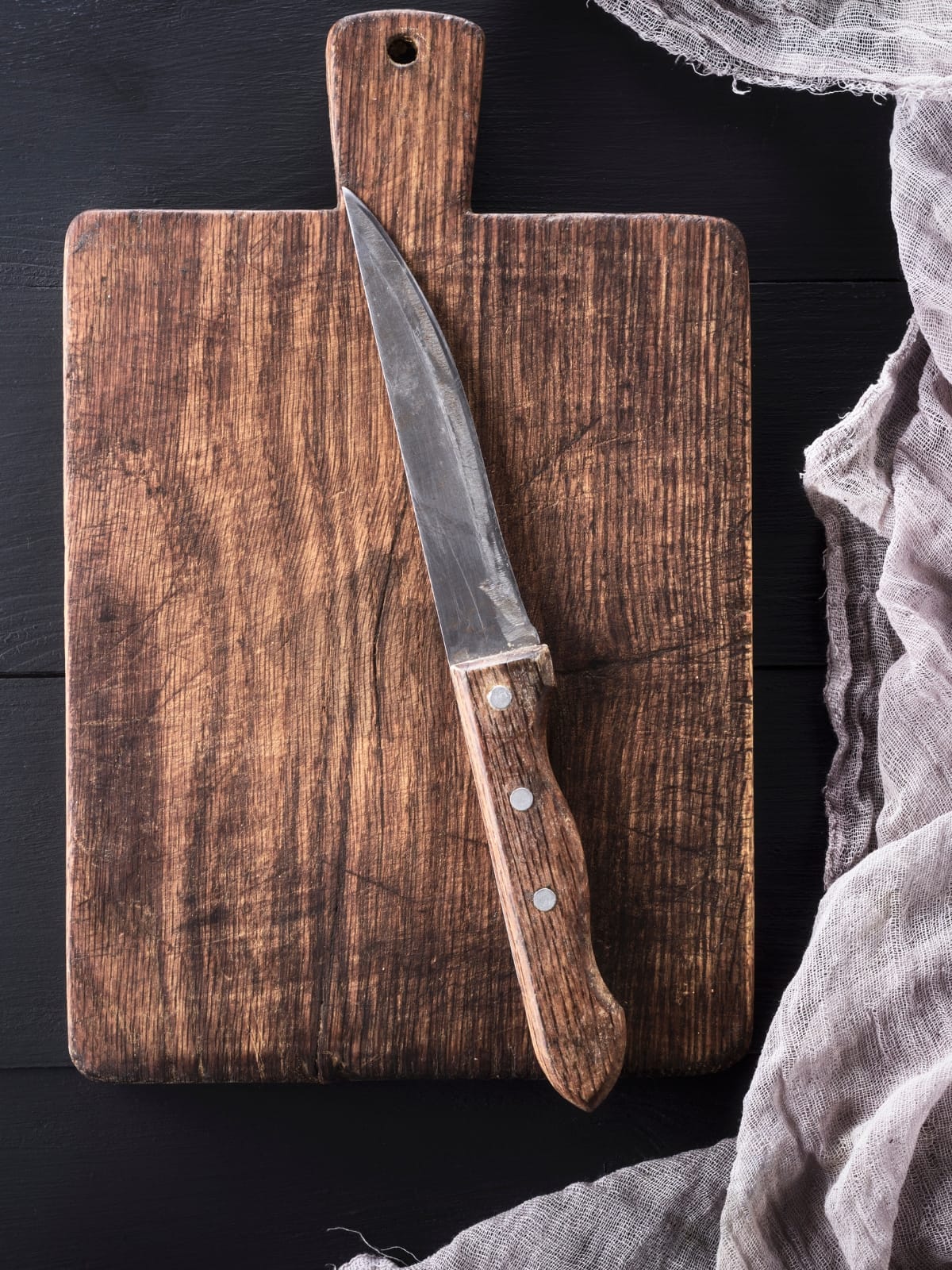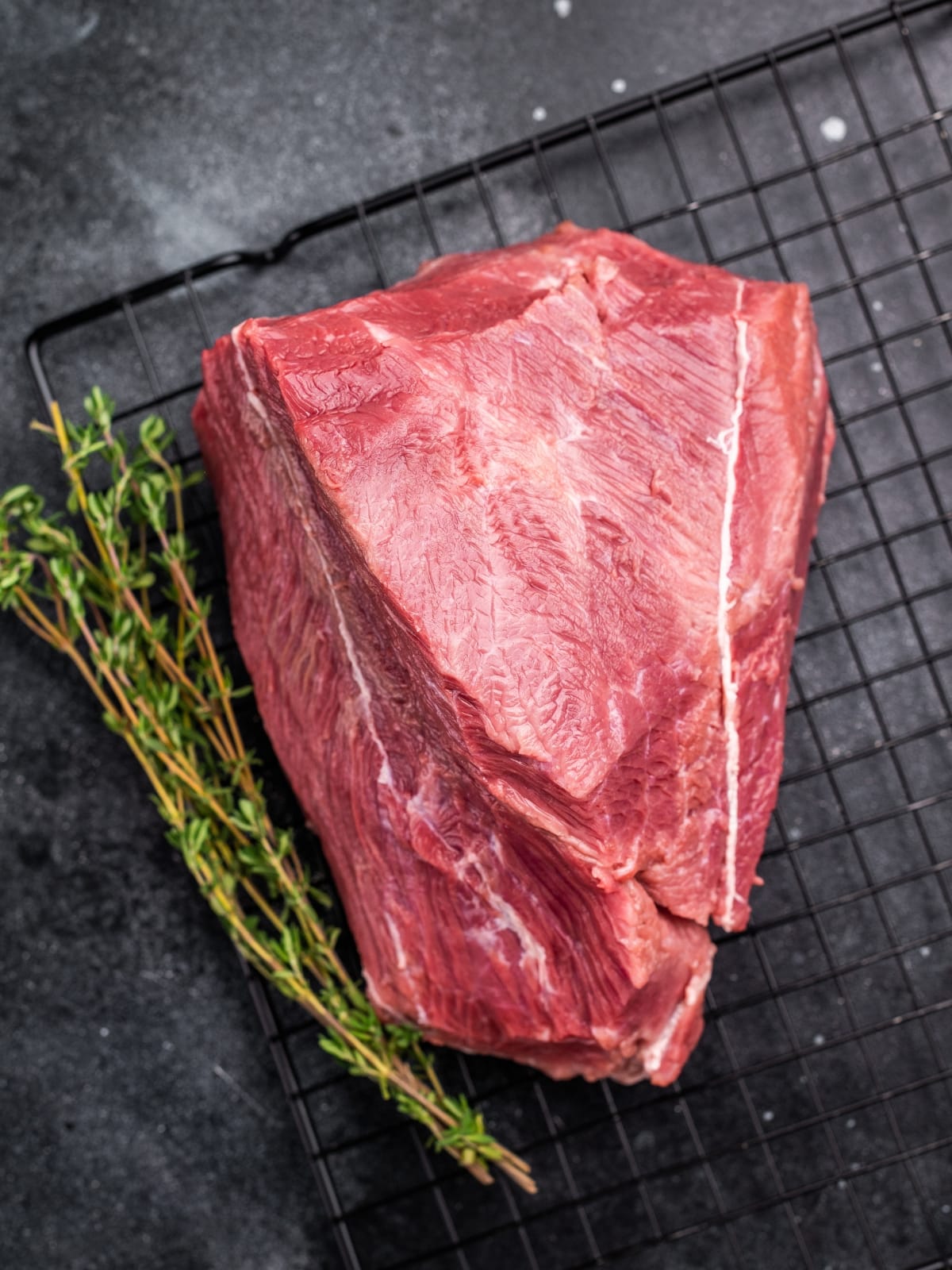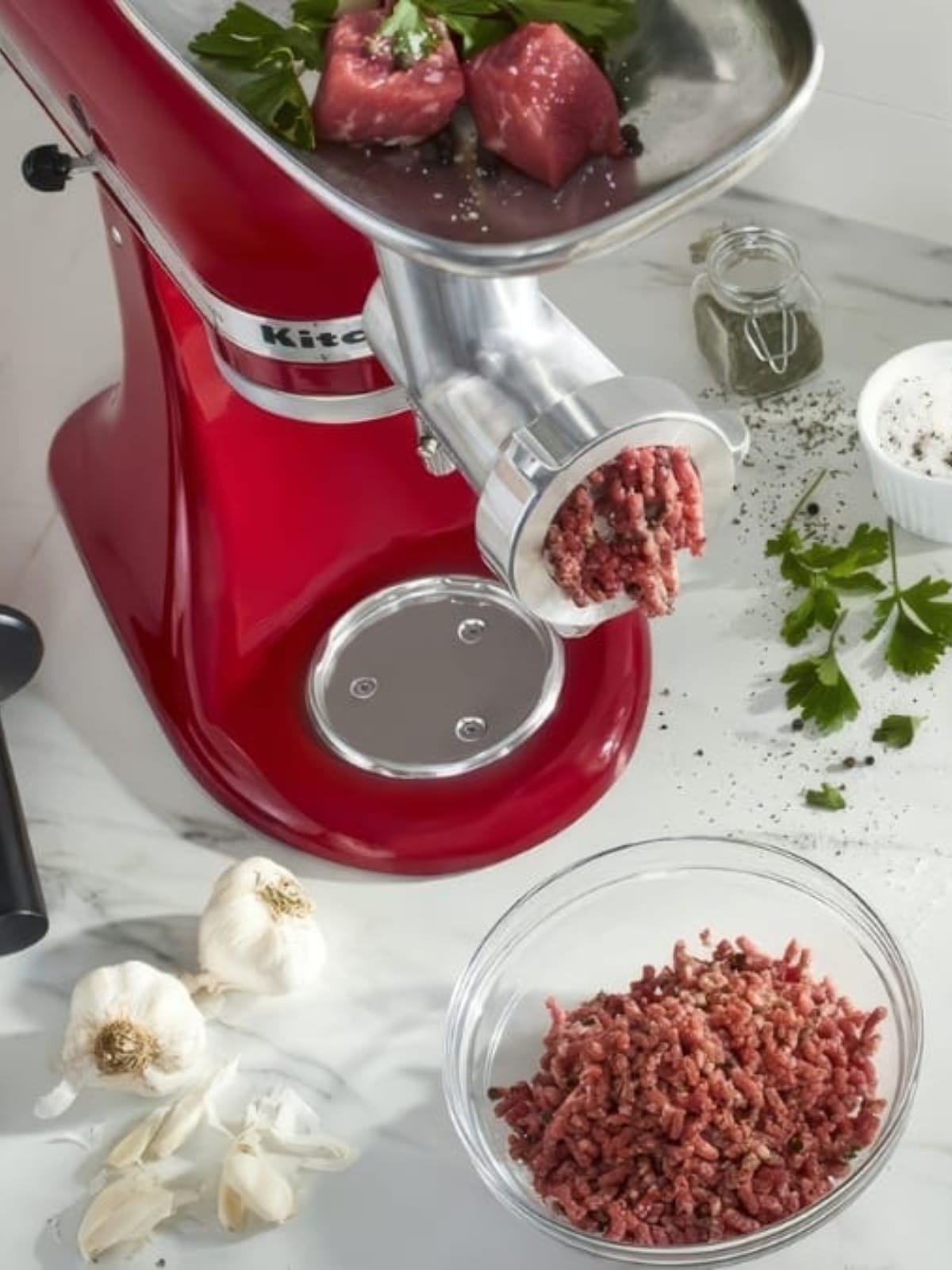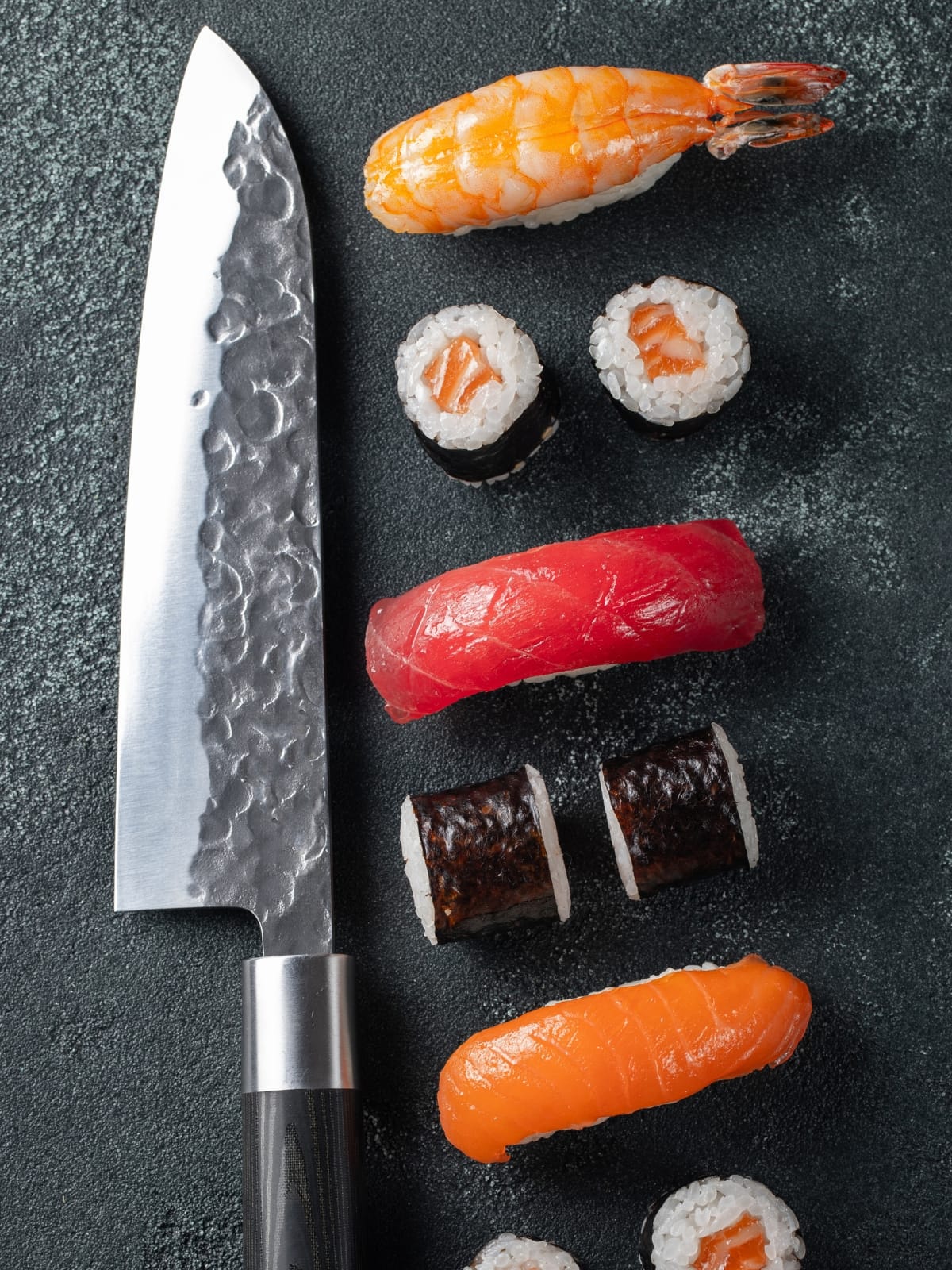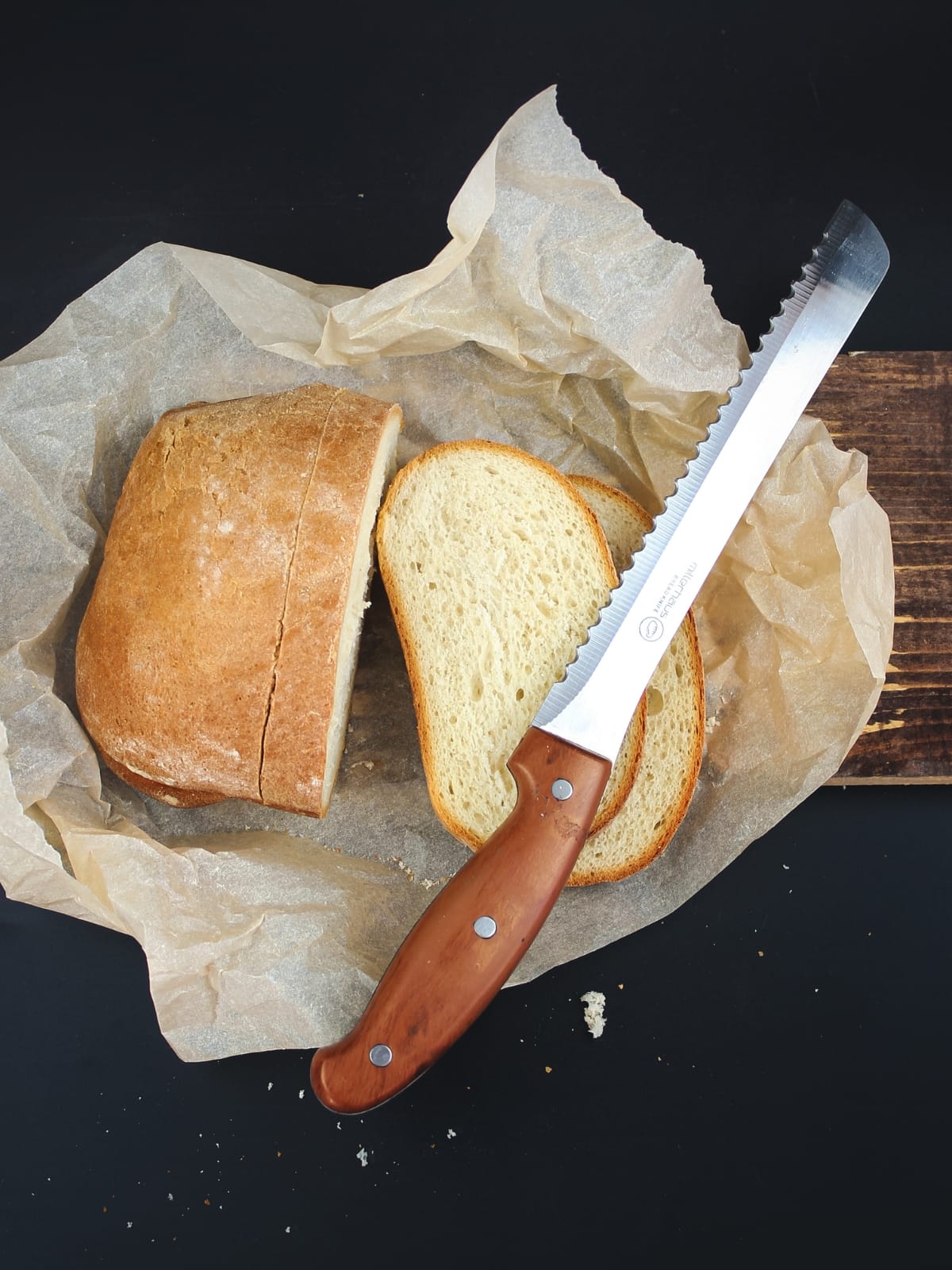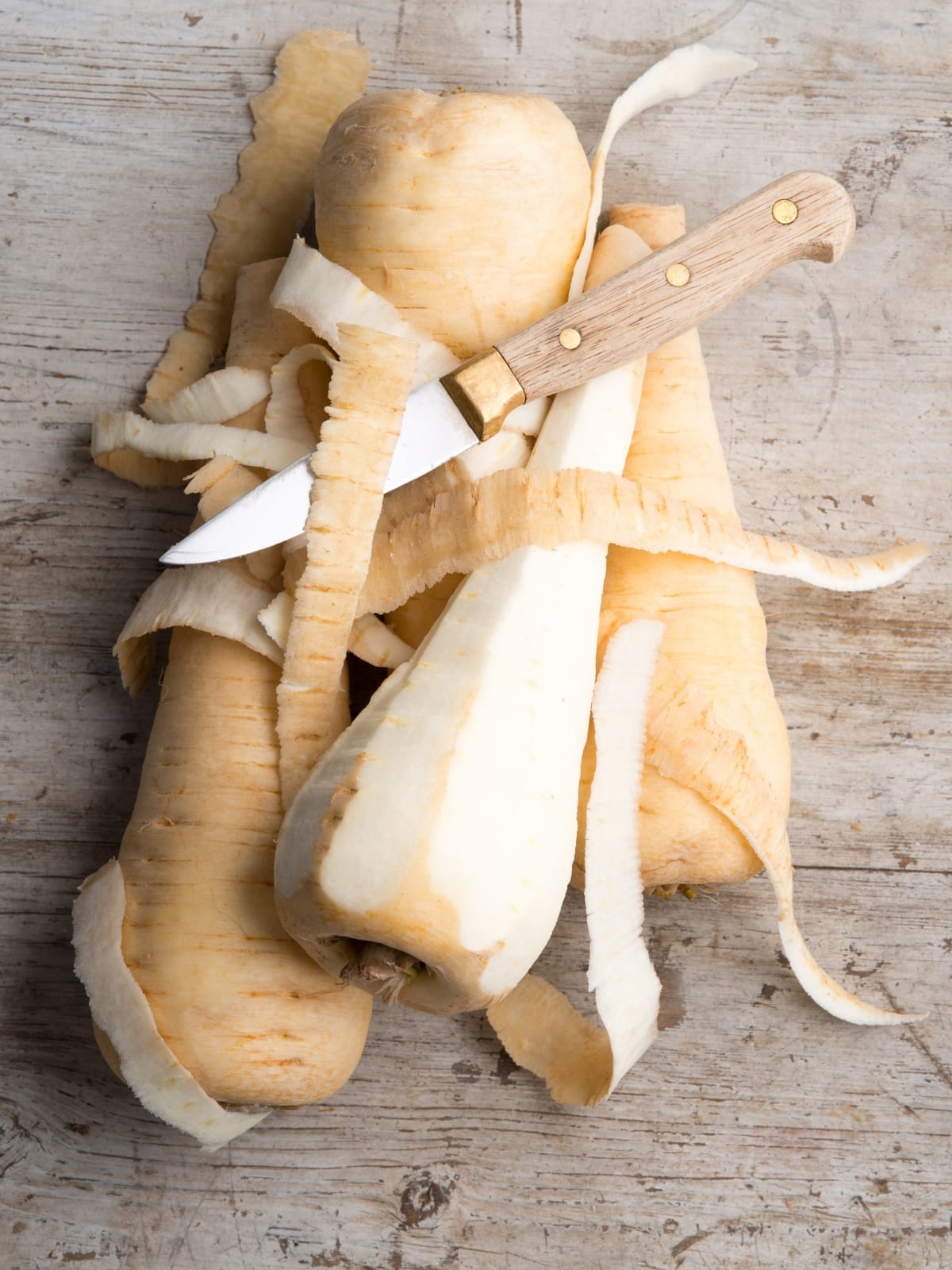Discover the best wood for kitchen knife handles, from classic hardwoods to exotic species. Learn how different wood types affect durability, grip comfort, and aesthetics while exploring maintenance tips and hybrid handle combinations that enhance your culinary experience.
Why Choose Wooden Handles for Kitchen Knives?
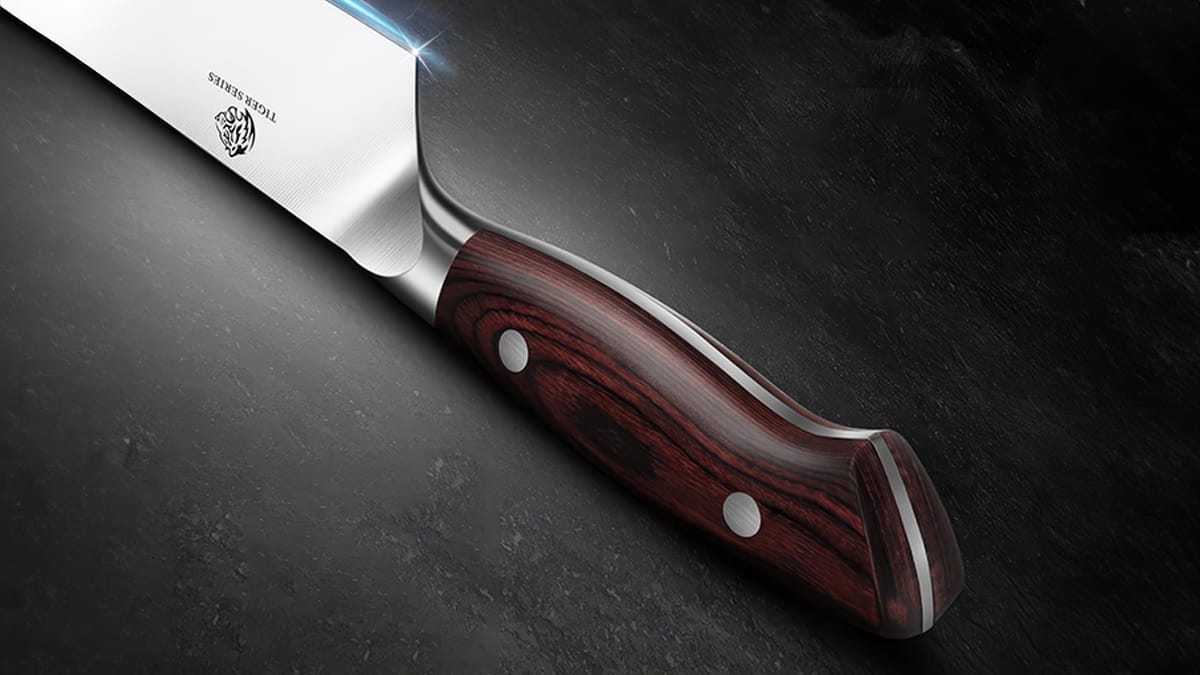
Wooden handles have been a popular choice for kitchen knives for centuries, and for good reason. Here are some compelling reasons to consider wooden handles:
- Traditional appeal and aesthetics: Wood brings a timeless, classic look to your kitchen knives, adding warmth and character to your culinary tools.
- Natural grip comfort: The natural texture and warmth of wood provide a comfortable grip, reducing hand fatigue during extended use.
- Temperature resistance: Unlike metal handles, wood doesn’t conduct heat or cold, making it comfortable to use in various cooking conditions.
- Customization potential: Wood can be easily shaped, carved, and finished to create unique, personalized handles that reflect your style.
Top Wood Species for Kitchen Knife Handles
When selecting the best wood for kitchen knife handles, it’s essential to consider various species, each with its unique properties and characteristics.
Premium Hardwoods
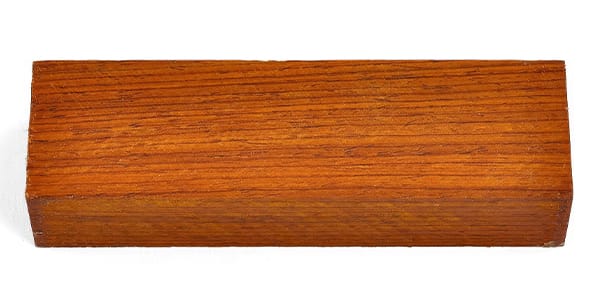
Cocobolo: This tropical hardwood is prized for its beautiful grain patterns and natural oils that provide water resistance. It’s dense, durable, and offers excellent grip.
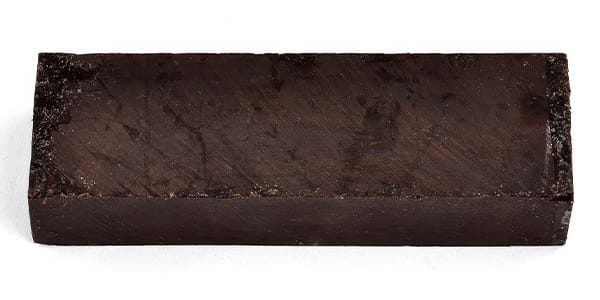
African Blackwood: One of the hardest and densest woods available, African Blackwood is extremely durable and resistant to moisture. Its dark color and fine grain make it a luxurious choice for high-end knives.
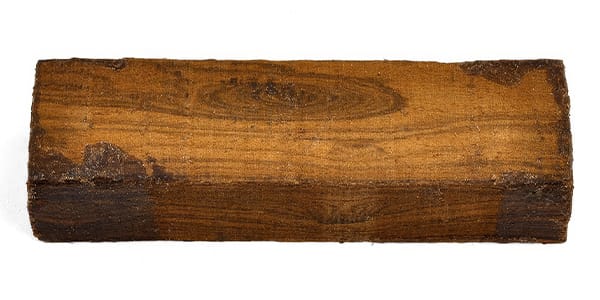
Bocote: Known for its striking grain patterns and natural luster, Bocote is a dense, oily wood that resists moisture and provides a comfortable grip.
Classic Hardwoods
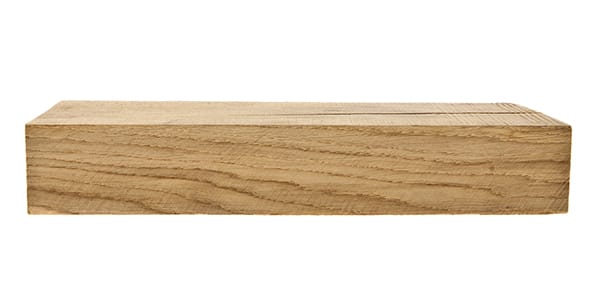
Oak: A traditional choice, oak is strong, durable, and widely available. It has a prominent grain pattern that provides excellent grip.
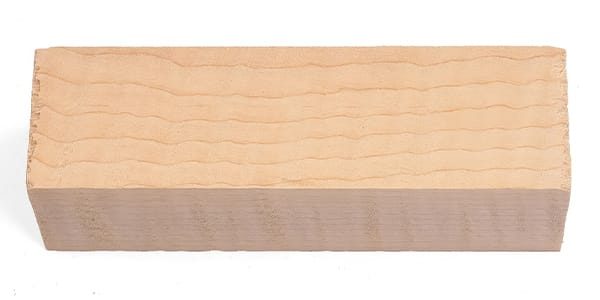
Maple: Hard maple is dense, durable, and resistant to wear. Its light color allows for easy customization with stains or dyes.
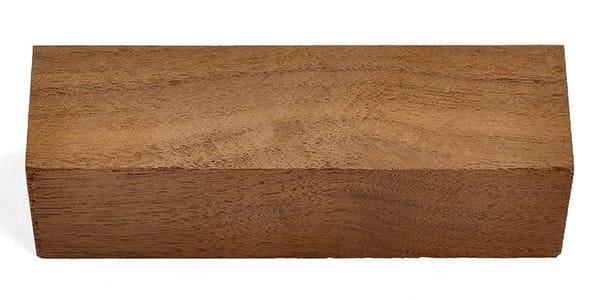
Walnut: With its rich, dark color and straight grain, walnut is a popular choice for knife handles. It’s moderately hard and provides good durability.
Exotic Woods
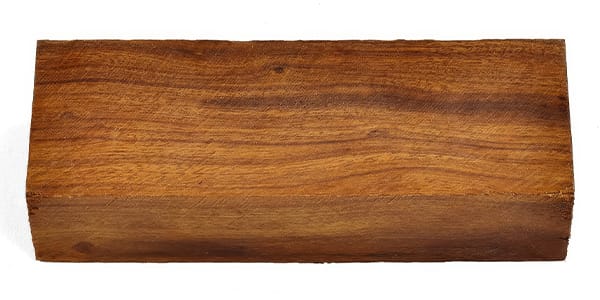
Desert Ironwood: Extremely dense and naturally oily, desert ironwood is highly prized for its durability and water resistance. It features a striking grain pattern and rich coloration.
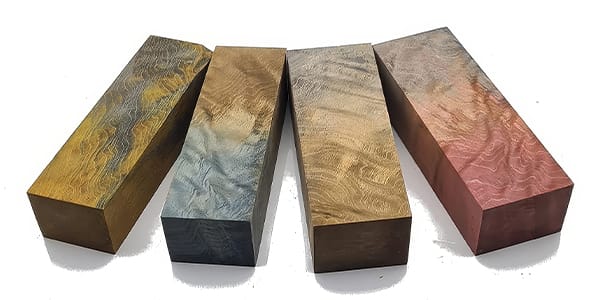
Stabilized Burls: Burls are abnormal tree growths that, when stabilized with resin, create unique, eye-catching patterns. They offer excellent durability and moisture resistance.
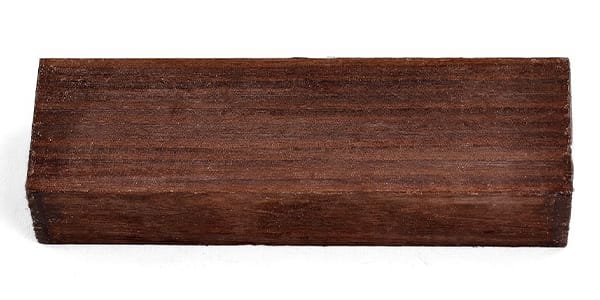
Rosewood: Known for its rich, reddish-brown color and fine grain, rosewood is dense, durable, and naturally oily, making it resistant to moisture.
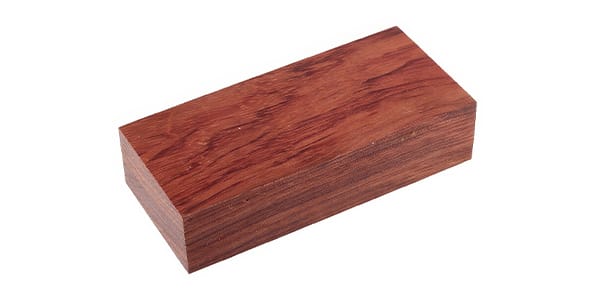
Bubinga: Known for its striking reddish-brown color with purple or pink undertones, is a dense and durable hardwood prized for its beautiful grain patterns.
Comparison Table
| Wood Type | Durability | Density | Hardness | Color | Moisture Resistance | Grain Pattern | Cost | Notable Features |
|---|---|---|---|---|---|---|---|---|
| Cocobolo | Excellent | High | Very High | Reddish-brown with dark veins | Excellent | Fine, often figured | High | Natural oils, exotic look |
| African Blackwood | Excellent | Very High | Extremely High | Dark brown to black | Excellent | Straight, fine | Very High | One of the hardest woods |
| Bocote | Very Good | High | High | Yellow with dark brown streaks | Very Good | Striking, often figured | High | Oily texture, unique patterns |
| Oak | Good | Medium | Medium-High | Light to medium brown | Moderate | Prominent, straight | Low | Traditional, good grip |
| Maple | Very Good | High | High | Pale cream to light brown | Good | Straight, sometimes figured | Medium | Versatile, takes stain well |
| Walnut | Good | Medium | Medium | Dark brown | Good | Straight to wavy | Medium | Rich color, classic look |
| Desert Ironwood | Excellent | Very High | Very High | Golden brown to dark brown | Excellent | Tight, often figured | Very High | Extremely dense, rare |
| Stabilized Burls | Excellent | Varies | High | Varies widely | Excellent | Highly figured | High | Unique patterns, customizable |
| Rosewood | Very Good | High | High | Reddish-brown | Very Good | Straight to interlocked | High | Aromatic, beautiful color |
| Bubinga | Very Good | High | High | Reddish-brown with purple or dark red streaks | Good | Straight to interlocked, sometimes wavy or figured | Medium to High | Beautiful figuring, takes a high polish, resistant to decay |
Factors to Consider When Choosing Wood for Knife Handles
When selecting the best wood for kitchen knife handles, consider the following factors:
Durability and Hardness
The Janka hardness scale measures the resistance of wood to denting and wear.
| Wood Species | Janka Hardness (lbf) |
|---|---|
| African Blackwood | 3,670 |
| Desert Ironwood | 3,260 |
| Stabilized Burls* | 1,500-3,000 |
| Cocobolo | 2,720 |
| Rosewood | 2,900 |
| Bubinga | 2,410 |
| Bocote | 2,200 |
| Hard Maple | 1,450 |
| Oak (Red) | 1,290 |
| Walnut | 1,010 |
*Stabilized Burls: Varies widely depending on the wood species and stabilization process, typically ranging from 1,500 to 3,000 lbf
Please note that these values can vary slightly depending on the specific species and growing conditions. For stabilized burls, the hardness can be significantly affected by the stabilization process, potentially increasing the hardness beyond the natural wood’s value.
Harder woods generally offer better durability but may be more challenging to work with during handle shaping and finishing.
Moisture Resistance
Woods with natural oils or those that have been stabilized offer better resistance to moisture, which is crucial for kitchen knives that are frequently exposed to water. Cocobolo, desert ironwood, and stabilized burls are excellent choices for moisture resistance.
Grain Pattern and Aesthetics
The grain pattern of wood can affect both its appearance and grip. Straight-grained woods like maple provide a consistent look, while figured woods like burls offer unique, eye-catching patterns. Consider your personal preferences and the overall aesthetic of your kitchen when choosing a wood type.
Cost Considerations
Wood prices can vary significantly based on rarity, figure, and demand. While premium exotic woods like desert ironwood can be expensive, more common hardwoods like oak or maple offer good performance at a lower cost. Balance your budget with your desired aesthetics and performance requirements.
Environmental Impact
Consider the sustainability of your chosen wood. Look for woods certified by the Forest Stewardship Council (FSC) or other reputable organizations to ensure responsible sourcing. Some exotic woods may be protected or restricted, so always verify the legality of your chosen wood species.
Hybrid Handle Materials: The Best of Both Worlds
Combining wood with other materials can create handles that offer the best of both worlds.
Benefits of Hybrid Handles
- Increased durability
- Enhanced moisture resistance
- Unique aesthetic appeal
- Improved balance and weight distribution
Here are some popular hybrid handle options:
Wood and Resin Combinations
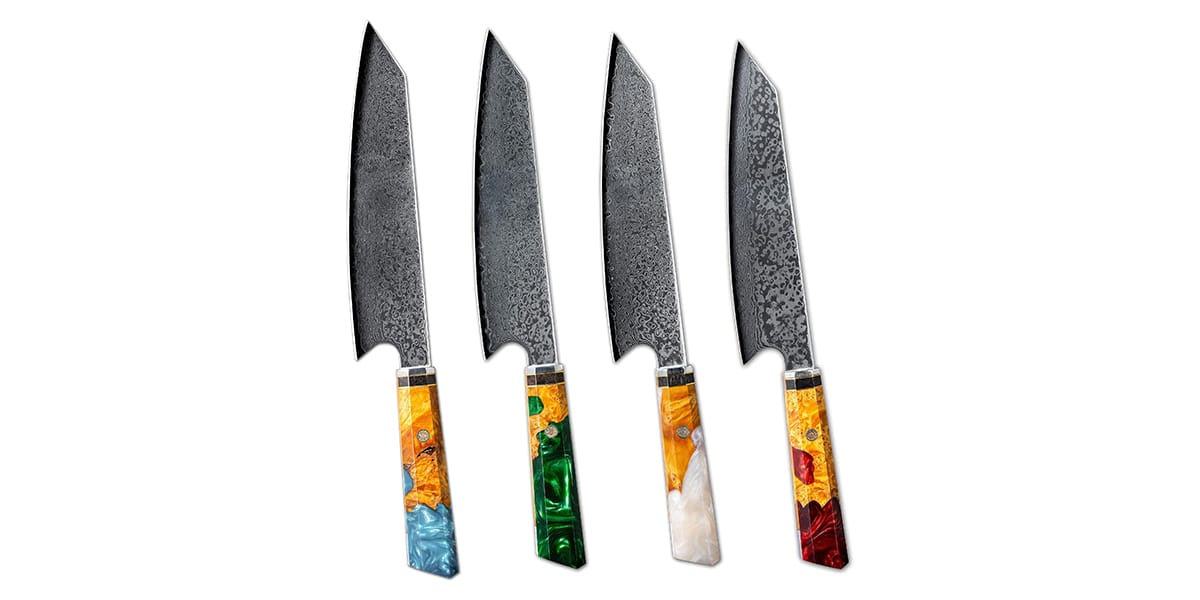
Wood stabilized with resin offers increased durability and moisture resistance while maintaining the natural beauty of wood. This process involves impregnating the wood with a clear or colored resin, filling voids and making the wood more stable.
Wood and Metal Composites
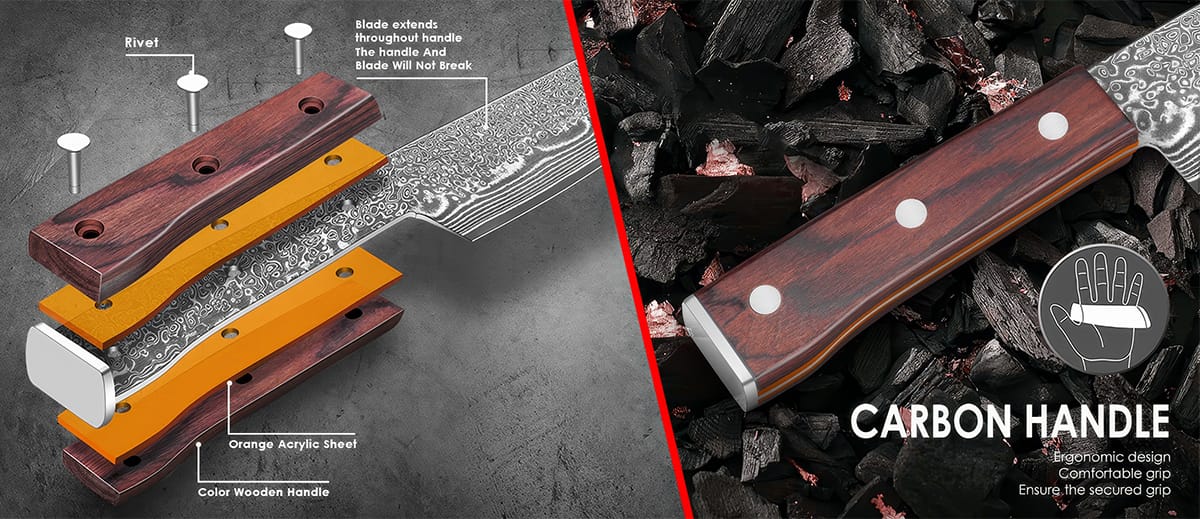
Some knife makers combine wood with metal elements, such as bolsters or end caps, to create a balance between the warmth of wood and the durability of metal. This combination can also add visual interest to the knife handle.
Micarta and Wood Hybrids
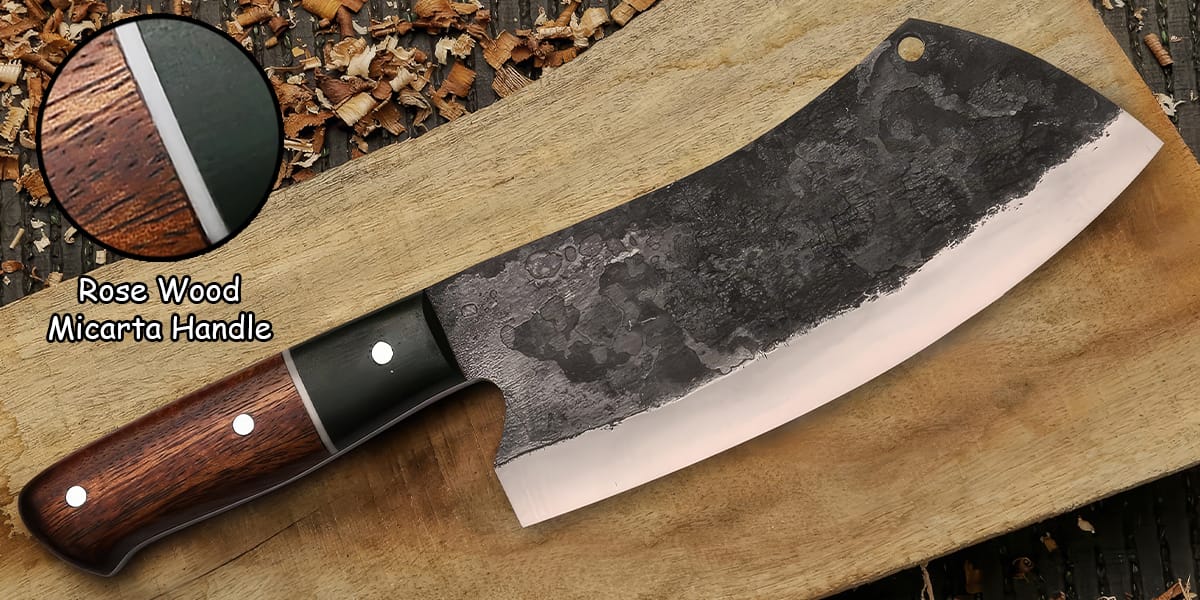
Micarta, a composite material made from layers of fabric or paper impregnated with resin, can be combined with wood to create handles that offer excellent durability and grip, even when wet.
Maintaining Wooden Knife Handles
Proper maintenance is crucial for preserving the beauty and functionality of wooden knife handles. Here are some essential tips:
Best Oils for Wooden Kitchen Knife Handles
Regular oiling helps protect wooden handles from moisture and keeps them looking their best. Here are some of the best oils for wooden kitchen knife handles:
- Mineral oil: Food-safe and widely available, mineral oil is an excellent choice for maintaining wooden handles. It’s inexpensive and doesn’t go rancid.
- Linseed oil: Boiled linseed oil (not raw) provides a durable finish and enhances the wood’s natural color. However, ensure it’s food-safe before use.
- Tung oil: This natural oil provides excellent water resistance and durability. Choose a 100% pure, food-safe version for kitchen knives.
- Camellia oil: Popular in Japanese knife care, camellia oil offers good protection and is food-safe.
To apply oil, simply rub a small amount into the handle with a clean cloth, allow it to soak in for a few minutes, then wipe off any excess. Repeat this process every few months or as needed.
Cleaning and Care Tips
- Avoid soaking wooden handles in water or putting them in the dishwasher.
- Clean handles with a damp cloth and mild soap, then dry immediately.
- Store knives in a dry place, preferably in a knife block or magnetic strip.
- Avoid extreme temperature changes, which can cause wood to expand or contract.
Refinishing Techniques
If your wooden handle becomes worn or damaged, you can refinish it:
- Sand the handle with progressively finer grits of sandpaper (e.g., 220, 400, 600).
- Clean off all dust with a tack cloth.
- Apply your chosen finish (oil, varnish, or lacquer) according to the product instructions.
- Allow the finish to cure completely before use.
For those looking to breathe new life into old or worn wooden handles, there are several effective restoration techniques. A detailed guide on restoring wood handles on knives can help you revitalize your cherished kitchen tools, saving you money and preserving the character of your knives.
Common Problems with Wooden Handles and Solutions
Despite their many benefits, wooden handles can sometimes encounter issues.
| Cracking and Splitting | Water Damage | Loose Handles | Discoloration |
|---|---|---|---|
| Cause: Rapid changes in humidity or temperature can cause wood to expand and contract, leading to cracks. | Cause: Prolonged exposure to water can cause swelling, warping, or discoloration. | Cause: Wood shrinkage or repeated exposure to moisture can cause handles to become loose. | Cause: UV exposure or chemical reactions can cause wood to change color over time. |
| Solution: Maintain a consistent environment for your knives and regularly oil the handles to keep them moisturized. | Solution: Dry handles immediately after washing and apply a water-resistant finish or oil regularly. | Solution: For full tang knives, tighten the rivets or pins. For hidden tang knives, a professional may need to reattach the handle. | Solution: Store knives away from direct sunlight and avoid harsh chemicals. Some color change is natural and can add character to the knife. |
How to Choose the Right Wood for Your Kitchen Knife
Selecting the best wood for kitchen knife handles depends on various factors:
Assessing Your Needs
Consider how you use your knives:
- Frequent use requires durable, moisture-resistant woods.
- Occasional use allows for more delicate or exotic woods.
Budget Considerations
Balance your desired aesthetics with your budget:
- Premium woods like desert ironwood or stabilized burls are expensive but offer unique looks and excellent performance.
- Classic hardwoods like oak or maple provide good value for money.
“When selecting wood for knife handles, consider not just the appearance but also how it will perform over time. Stabilized woods offer a great balance of beauty and durability for kitchen use.” – Master bladesmith John Smith
Professional vs. Home Use
Professional chefs may prioritize durability and grip over aesthetics, while home cooks might prefer a balance of form and function.
“I prefer dense, oily woods like cocobolo for my kitchen knives. They provide excellent grip even when my hands are wet and stand up well to the rigors of a professional kitchen.” – Chef Maria Rodriguez of La Cocina Auténtica
Climate Factors
Consider your local climate:
- Humid environments require woods with good moisture resistance.
- Dry climates may allow for a wider range of wood options.
FAQs
How long do wooden handles last?
With proper care, wooden handles can last for decades. Regular oiling and avoiding extreme conditions will help prolong their life.
Can wooden handles go in the dishwasher?
No, wooden handles should never be put in the dishwasher. The heat and moisture can cause warping, cracking, and other damage.
How often should I oil my knife handles?
It depends on use and environment, but generally every 1-3 months is sufficient. If the wood looks dry or feels rough, it’s time to oil.
Which wood is most water-resistant?
Naturally oily woods like teak, cocobolo, and desert ironwood offer excellent water resistance. Stabilized woods also perform well in moist environments.
Conclusion
Selecting the best wood for kitchen knife handles requires balancing aesthetics, durability, comfort, and maintenance needs. Consider your cooking style, local climate, and budget when choosing between classic hardwoods, exotic species, or hybrid materials. With proper care, wooden-handled knives can become cherished tools that develop a rich patina over time. For more insights, explore our guides on basic Japanese kitchen knives and top kitchen knives under $50.
